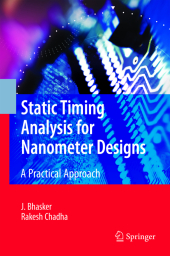 Neuerscheinungen 2011Stand: 2020-01-07 |
Schnellsuche
ISBN/Stichwort/Autor
|
Herderstraße 10
10625 Berlin
Tel.: 030 315 714 16
Fax 030 315 714 14
info@buchspektrum.de |

J. Bhasker, Rakesh Chadha
(Beteiligte)
Static Timing Analysis for Nanometer Designs
A Practical Approach
Repr. 2011. xx, 572 S. 225 SW-Abb., 10 Tabellen. 235 mm
Verlag/Jahr: SPRINGER, BERLIN; SPRINGER US 2011
ISBN: 1-441-94715-9 (1441947159)
Neue ISBN: 978-1-441-94715-4 (9781441947154)
Preis und Lieferzeit: Bitte klicken
This reference on static timing analysis for semiconductors proceeds from simple to complex and covers such topics as cell timing and power modeling, delay calculation and crosstalk. Each topic includes theoretical background and detailed examples.
iming, timing, timing! That is the main concern of a digital designer charged with designing a semiconductor chip. What is it, how is it T described, and how does one verify it? The design team of a large digital design may spend months architecting and iterating the design to achieve the required timing target. Besides functional verification, the t- ing closure is the major milestone which dictates when a chip can be - leased to the semiconductor foundry for fabrication. This book addresses the timing verification using static timing analysis for nanometer designs. The book has originated from many years of our working in the area of timing verification for complex nanometer designs. We have come across many design engineers trying to learn the background and various aspects of static timing analysis. Unfortunately, there is no book currently ava- able that can be used by a working engineer to get acquainted with the - tails of static timing analysis. The chip designers lack a central reference for information on timing, that covers the basics to the advanced timing veri- cation procedures and techniques.
STA Concepts.- Standard Cell Library.- Interconnect Parasitics.- Delay Calculation.- Crosstalk and Noise.- Configuring the STA Environment.- Timing Verification.- Interface Analysis.- Robust Verification.


